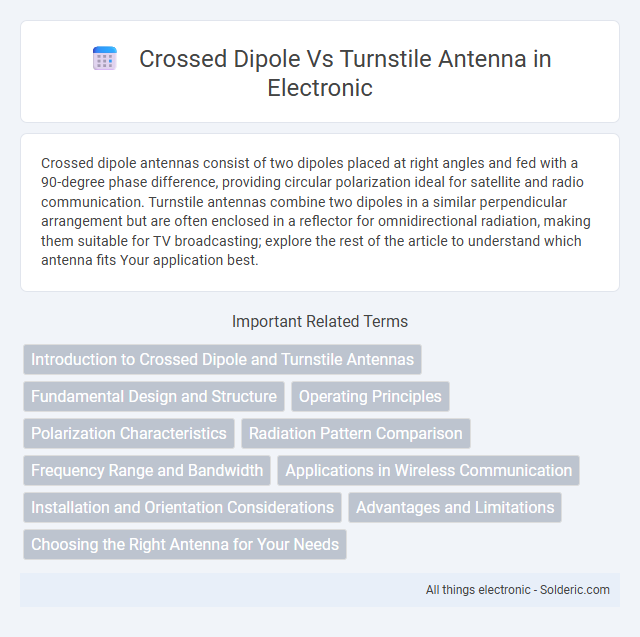Crossed dipole antennas consist of two dipoles placed at right angles and fed with a 90-degree phase difference, providing circular polarization ideal for satellite and radio communication. Turnstile antennas combine two dipoles in a similar perpendicular arrangement but are often enclosed in a reflector for omnidirectional radiation, making them suitable for TV broadcasting; explore the rest of the article to understand which antenna fits Your application best.
Comparison Table
| Feature | Crossed Dipole Antenna | Turnstile Antenna |
|---|---|---|
| Structure | Two dipoles crossed at 90deg, typically orthogonally mounted | Two dipoles crossed at 90deg, fed in phase quadrature with a phasing harness |
| Polarization | Circular or linear, depending on feeding method | Primarily circular polarization |
| Radiation Pattern | Omnidirectional horizontal pattern with some nulls | Omnidirectional, uniform horizontal radiation pattern |
| Feed Mechanism | Often fed with 90deg phase difference for circular polarization | Fed with 90deg phase shift between dipoles for circular polarization |
| Applications | FM broadcasting, VHF/UHF communications, satellite tracking | VHF/UHF broadcasting, satellite communication, space telemetry |
| Gain | Typically 3 dBi | Approximately 3 dBi |
| Advantages | Simple design, adjustable polarization | Stable circular polarization, good omnidirectional coverage |
Introduction to Crossed Dipole and Turnstile Antennas
Crossed dipole antennas consist of two dipoles mounted perpendicular to each other, providing circular polarization and improved signal reception in multiple directions. Turnstile antennas, formed by two dipoles oriented at right angles and fed in phase quadrature, offer nearly omnidirectional radiation patterns ideal for broadcasting. Understanding these antenna types helps you select the best solution for applications requiring uniform coverage and polarization diversity.
Fundamental Design and Structure
Crossed dipole antennas consist of two dipole antennas mounted perpendicularly, creating orthogonal polarization that enhances signal reception and transmission diversity. Turnstile antennas combine two dipoles arranged at right angles with a 90-degree phase difference, producing nearly circular polarization ideal for omnidirectional communication. The fundamental structure of crossed dipoles prioritizes simple linear polarization diversity, while turnstile antennas focus on generating circular polarization through precise phase shifting.
Operating Principles
Crossed dipole antennas consist of two dipoles mounted at right angles with their currents phase-shifted by 90 degrees, creating circular polarization ideal for satellite communications. Turnstile antennas also use two perpendicular dipoles but include a phasing coil or network to maintain the 90-degree phase difference, producing omnidirectional patterns in the horizontal plane. Your choice depends on desired polarization and radiation patterns, as crossed dipoles are simpler while turnstiles offer more consistent omnidirectional coverage.
Polarization Characteristics
Crossed dipole antennas produce circular polarization through two orthogonal dipoles fed with a 90-degree phase difference, enabling consistent signal quality regardless of the receiver's orientation. Turnstile antennas also achieve circular polarization by combining two dipoles at right angles, but they generally offer broader bandwidth and more uniform omnidirectional radiation patterns. The polarization purity of crossed dipoles tends to be higher, making them ideal for applications requiring precise polarization control such as satellite communication and radio astronomy.
Radiation Pattern Comparison
Crossed dipole and turnstile antennas both exhibit omnidirectional radiation patterns in the horizontal plane, but the turnstile antenna produces a more uniform circular pattern with reduced nulls. Crossed dipoles generate a figure-eight pattern when driven in phase, creating two main lobes perpendicular to each dipole element. Your choice depends on whether you need broader omnidirectional coverage (turnstile) or more directional nulls for reducing interference (crossed dipole).
Frequency Range and Bandwidth
Crossed dipole antennas typically operate within a narrower frequency range with moderate bandwidth, making them ideal for applications requiring stable polarization and consistent performance over specific bands. Turnstile antennas offer broader bandwidth and can cover wider frequency ranges due to their design, which allows for improved omnidirectional radiation patterns. Your choice between these antennas depends on whether you prioritize frequency versatility or consistent signal quality within a limited band.
Applications in Wireless Communication
Crossed dipole antennas offer broad polarization diversity, making them ideal for satellite communication and radar systems where signal reliability under varying orientations is critical. Turnstile antennas, with their omnidirectional pattern and circular polarization, excel in VHF/UHF broadcasting and FM radio transmission, ensuring consistent coverage in urban environments. Both antenna types enhance wireless communication performance by minimizing signal fading and multipath interference in their respective frequency bands.
Installation and Orientation Considerations
Crossed dipole antennas require precise installation with orthogonal elements positioned at 90 degrees to achieve circular polarization, ensuring optimal signal reception. Turnstile antennas, composed of two dipoles mounted at right angles with a common feed, simplify alignment but demand careful attention to element spacing and height for uniform radiation patterns. Your choice depends on the ease of mounting and the specific polarization needs of your communication system.
Advantages and Limitations
Crossed dipole antennas offer improved polarization diversity and broader bandwidth compared to turnstile antennas, making them suitable for applications requiring circular polarization and multi-directional coverage. However, crossed dipoles typically have a more complex feed network and can exhibit increased insertion loss. Turnstile antennas provide simpler construction and reliable omnidirectional radiation patterns but often have narrower bandwidth and less effective polarization purity.
Choosing the Right Antenna for Your Needs
Crossed dipole antennas provide enhanced circular polarization and improved signal quality, ideal for satellite communications and applications requiring consistent orientation. Turnstile antennas offer omnidirectional coverage with broad frequency bandwidth, making them suitable for VHF and UHF broadcasting or receiving signals from multiple directions. Selecting the right antenna depends on specific needs such as polarization type, coverage area, and frequency range.
crossed dipole vs turnstile antenna Infographic

 solderic.com
solderic.com